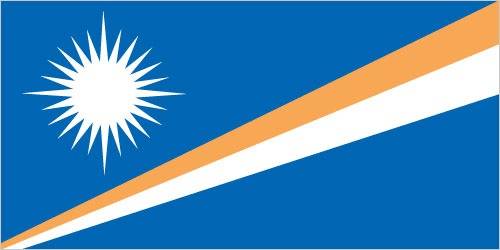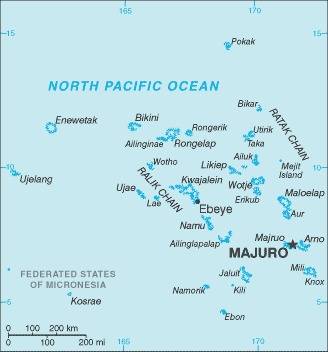40 Marshall Islands

Blue with two stripes radiating from the lower hoist-side corner – orange (top) and white. A white star with four large rays and 20 small rays appears on the hoist side above the two stripes. Blue represents the Pacific Ocean, the orange stripe signifies the Ralik Chain or sunset and courage, while the white stripe signifies the Ratak Chain or sunrise and peace. The star symbolizes the cross of Christianity, each of the 24 rays designates one of the electoral districts in the country and the four larger rays highlight the principal cultural centers of Majuro, Jaluit, Wotje, and Ebeye. The rising diagonal band can also be interpreted as representing the equator, with the star showing the archipelago’s position just to the north.
Flag courtesy of the CIA World Factbook

Map courtesy of the CIA World Factbook

Aerial view of Runit Dome (or Cactus Dome) on Runit Island in Enewetak Atoll. Between 1977 and 1980, the crater created by the Cactus shot of Operation Hardtack I was used as a burial pit to inter 84,000 cubic meters of radioactive soil scraped from the various contaminated Enewetak Atoll islands. The Runit Dome was built to cover the material.
Photo courtesy of the CIA World Factbook
Government
According to Britannica, under the constitution adopted in 1979, the government consists of a president elected by a unicameral, 33-member parliament known as the Nitijela. The Council of Iroij (Chiefs) has mainly a consultative function, concerned with traditional laws and customs. Hospitals on Majuro and Ebeye (part of Kwajalein Atoll) and dispensaries on other islands provide health care. There are primary schools, both public and church-run, on the inhabited islands and islets. Majuro and Jaluit atolls each have a public secondary school. Majuro is also the site of the College of the Marshall Islands (1993), which grants certificates and associate degrees in a variety of programs.
Marshall Islands Port Authority
The Directorate of Civil Aviation of the Marshall Islands was established in 2003 under the Minister of Transportation and Communication.
Airspace
SkyVector – Google Maps – ADS-B Exchange
ICAO countries publish an Aeronautical Information Publication (AIP). This document is divided into three parts: General (GEN), En Route (ENR) and Aerodromes (AD). ENR 1.4 details the types of airspace classes they chose to adopt from classes A through G.
Drone Regulations
None found by the author.
However, should you, the reader, happen to stumble across something to the contrary, please email the author at FISHE5CA@erau.edu and you may be mentioned in the ACKNOWLEDGEMENTS section of this book by way of thanks for contributing to this free eBook!
Advanced Air Mobility (AAM) Regulations & Policies
Advanced Air Mobility (AAM) News
None found by the author.
However, should you, the reader, happen to stumble across something to the contrary, please email the author at FISHE5CA@erau.edu and you may be mentioned in the ACKNOWLEDGEMENTS section of this book by way of thanks for contributing to this free eBook!
Short Essay Questions
Scenario-Based Question
You have been hired by a Drone Startup Company. Your boss has immediately assigned this job to you.
They need you to prepare a one-page memo detailing the legalities of using a drone over Cactus Dome, pictured above.
They need you to mention any national laws and local ordinances.
They specifically want to know what airspace (insert pictures) you will be operating in and whether or not you need an airspace authorization.
Does it matter whether or not you are a citizen of the country?
Lastly, there is a bonus for you if, as you scroll through this chapter, you find any typos or broken links!
Short Essay Questions
- What are the drone categories?
- How is registration addressed?
- How is remote ID addressed?
- What are the model aircraft rules?
- What are the commercial drone rules?
- Are there waivers or exemptions to the rules? If so, for what?
- Would you share a link to an interactive airspace map?
- How is BVLOS addressed?
- How can you fly drones at night?
- How can you fly drones over people?
- Where do you find drone NOTAMs?
- What are the rules for drone maintenance?
- What are the rules for an SMS program?
- What are some unique rules not mentioned above?
- What are the C-UAS rules?
- What are the AAM rules?

